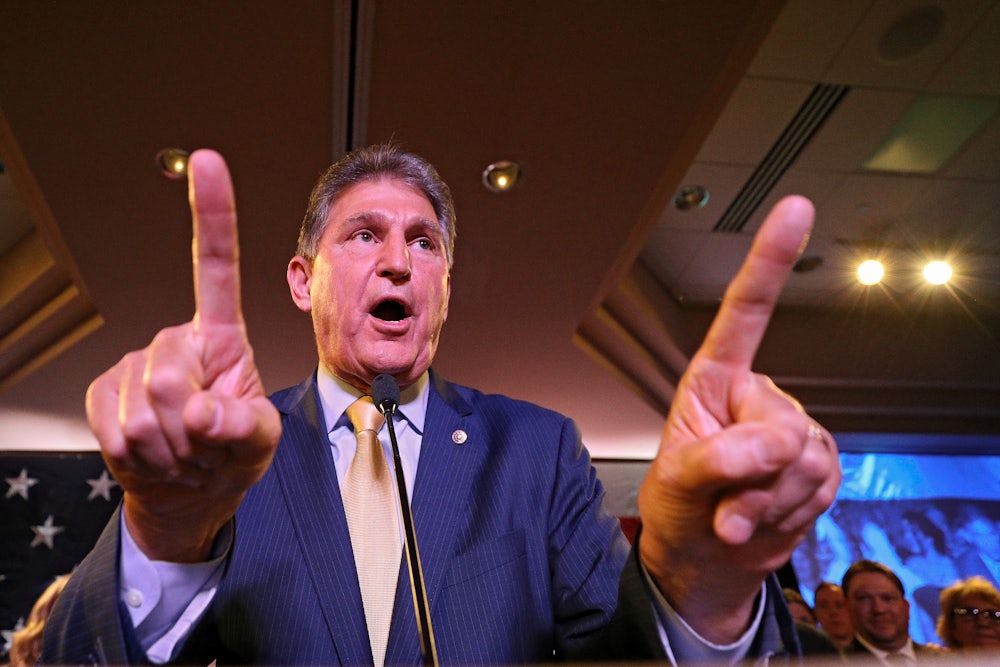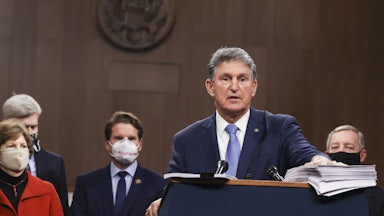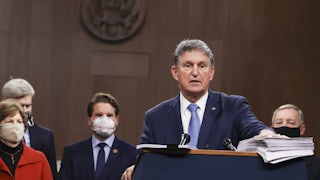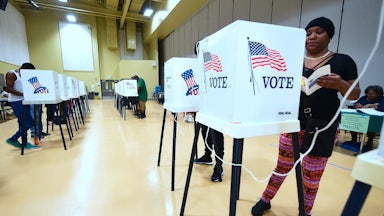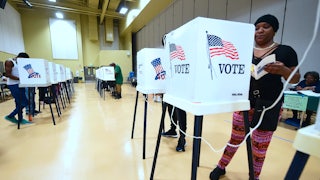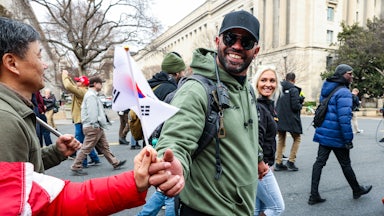West Virginia Senator Joe Manchin, the nation’s de facto prime minister, threw cold water this week on the Democrats’ signature election-reform bill. The For the People Act would expand early voting, curb gerrymandering, and enact new campaign-finance restrictions. But Manchin suggested that he wouldn’t be willing to make major reforms without bipartisan support, effectively killing them.
His announcement is a grievous blow to a bill that was already facing a tough road to passage. But rather than just shrug and move on, the conservative Democratic senator instead charted a more interesting way forward. He threw his weight behind the John Lewis Voting Rights Advancement Act, an update to the Voting Rights Act of 1965, and proposed applying its most sweeping provision to every state in the Union.
“I believe Democrats and Republicans feel very strongly about protecting the ballot boxes, allowing people to protect the right to vote, making it accessible, making it fair, and making it secure, and the John Lewis Voting Rights Act, if we apply that to all 50 states and territories, it’s something that can be done, it should be done,” Manchin told ABC News earlier this week. “It could be done bipartisan to start getting confidence back in our system.”
Why does this change matter so much? The Voting Rights Act of 1965, or VRA, had two major provisions. One of them, known as Section 2, imposed a permanent nationwide ban on voting discrimination on the basis of race and allowed plaintiffs to sue for violations of it in federal court. (The court is currently mulling the scope of Section 2 in a case out of Arizona.) The other provision, known as Section 5, required certain states and localities with a history of pervasive voter disenfranchisement to obtain approval from the federal government before changing their election and voting laws.
Many observers, including the Supreme Court itself, credit Section 5’s preclearance regime with the sharp rise in voter enfranchisement after decades of Jim Crow suppression in the South. In the 2013 case Shelby County v. Holder, however, the court brought the preclearance era to an end. Chief Justice John Roberts, writing for the majority, described preclearance as a “dramatic departure from the principle that all states enjoy equal sovereignty.” Though this “strong medicine” was necessary in 1965 to remedy decades of voter suppression by Jim Crow laws and practices, he concluded, such measures were no longer appropriate in 2013.
Congress theoretically has broad powers to prevent racial discrimination in voting laws under the Fifteenth Amendment. It also decides how federal elections can be conducted. But the Roberts court limited those powers on other grounds. “Despite the tradition of equal sovereignty, the [VRA] applies to only nine states (and several additional counties),” Roberts wrote. “While one State waits months or years and expends funds to implement a validly enacted law, its neighbor can typically put the same law into effect immediately, through the normal legislative process.” This disparity, he concluded, was constitutionally untenable.
The court ultimately declined to strike down the preclearance system itself as outlined in Section 5. Instead, it struck down the formula used to determine which states fell under the preclearance system in Section 4(b). Without that formula, preclearance still legally exists, but no jurisdictions currently fall under it. And while Republicans once backed the VRA with near-unanimous support, their staunch opposition to a new formula since 2013 has prevented Congress from enacting one.
From whence does this principle of “equal sovereignty” between the states spring? In Shelby County, Roberts traced it to the 2009 case Northwest Austin Municipal Utility District No. One v. Holder, for which he also wrote the majority opinion. That ruling allowed a small Texas utility district to try to move out from the preclearance regime. But the case’s true significance was as a warning shot for preclearance in general, all but inviting future challenges to its constitutionality.
“Some of the conditions that we relied upon in upholding this statutory scheme in [South Carolina v.] Katzenbach and City of Rome [v. United States] have unquestionably improved,” Roberts wrote in Northwest Austin. “Things have changed in the South. Voter turnout and registration rates now approach parity. Blatantly discriminatory evasions of federal decrees are rare. And minority candidates hold office at unprecedented levels.”
While this could be a reason for Congress to reconsider preclearance on policy grounds, it does not amount to a legal basis for a court to overturn or undermine the VRA. Laws aren’t unconstitutional simply because they work well. Something more would be needed for the Supreme Court to act. Roberts and the majority homed in on the idea that preclearance might violate the “principle of equal sovereignty” among the states. This principle isn’t explicitly stated in the Constitution; the court extrapolated it from the Supremacy Clause, the Tenth Amendment, and other pillars of American federalism.
There was just one slight problem. In Katzenbach, the 1966 case in which South Carolina unsuccessfully challenged the VRA’s provisions, the Supreme Court explicitly rejected the idea that equal sovereignty was relevant to the law. “The doctrine of the equality of States, invoked by South Carolina, does not bar this approach, for that doctrine applies only to the terms upon which States are admitted to the Union, and not to the remedies for local evils which have subsequently appeared,” Earl Warren wrote for the court.
In other words, while all states are created equal, they can be treated differently afterward. Roberts disagreed. He decided to read Katzenbach’s plain dismissal of the equal sovereignty claim as something else entirely. “Distinctions can be justified in some cases,” he explained, inverting the court’s hands-off approach to the question. Roberts then gave a tortured quotation of the court’s previous statement in Katzenbach to support his point: “The doctrine of the equality of States … does not bar … remedies for local evils which have subsequently appeared.” Omitted entirely was Warren’s explicit statement that the doctrine didn’t apply at all.
As Ruth Bader Ginsburg noted in her famous Shelby County dissent, this was little more than a bait and switch. “In today’s decision, the Court ratchets up what was pure dictum in Northwest Austin, attributing breadth to the equal sovereignty principle in flat contradiction of Katzenbach,” she wrote. “The Court does so with nary an explanation of why it finds Katzenbach wrong, let alone any discussion of whether stare decisis nonetheless counsels adherence to Katzenbach’s ruling on the limited ‘significance’ of the equal sovereignty principle.”
Ginsburg also noted that the broadened principle outlined by the majority was “capable of much mischief.” She cited numerous federal statutes that defy the principle by allocating resources based on total population, population density, or other characteristics. (Imagine if each state received equal allotments of Covid-19 vaccines.) Congress also does not subsidize solar farms in Alaska or build Navy bases in Oklahoma. Governing a country that spans a continent necessarily means treating some parts of it differently than other parts. If that principle can be bent for basic spending, it can also bend for voting rights enforcement.
Manchin’s proposal takes the Roberts court’s bad-faith reading of the VRA in good faith. If the Supreme Court is uncomfortable with placing some states under a preclearance regime, the logical remedy is simply to subject every state to the same scrutiny. After all, as my colleague Nick Martin took pains to point out, the states of the Jim Crow South have hardly cornered the market on voter suppression.
This might be “strong medicine,” as the court once put it. But perhaps strong medicine is what the Union needs. After Shelby County, Republicans passed a wide range of measures to make it harder to cast a ballot. Donald Trump’s defeat in 2020 only accelerated this impulse on the American right. GOP state lawmakers across the country have introduced more than 300 bills this year alone to restrict voter access. The problem is no longer limited to the Deep South: It’s a nationwide menace.
Unfortunately, Manchin’s plan is not bulletproof. It’s unclear how the Roberts court would view another preclearance formula if it were enacted into law. Though his proposal cures the problem outlined in Shelby County, the court’s conservative supermajority may instead decide to scrap Section 5 altogether on some other grounds. More immediately, Manchin’s continued opposition to scrapping or reforming the filibuster makes it doubtful that even his proposal can get through the chamber where the For the People Act could not. For once, at least, he’s moving in the right direction.
